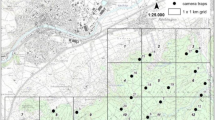Summary
With diurnally active predators like Notiophilus biquttatus F. food deprivation is involved in predation in two ways: as a consequence of food shortage (i.e., low prey density), and as a consequence of the night period. The pattern of food intake after deprivation at night has been studied with respect to two prey species and differently deprived predators. They prey species represent a locomotory active one (Orchesella cincta) and a locomotory inactive one (Tomocerus minor). It appears that the rate of predation after deprivation shows a distinct pattern, initially high and then slowing to a more or less constant value. This pattern is influenced by food deprivation and type of prey. The beetles preying on O. cincta consumed more prey than those preying on T. minor. The more deprived predators compensated for deprivation by a higher daily predation when O. cincta was the prey, but not when T. minor was. Consequences of these findings are discussed with respect to diet composition and functional response.
Similar content being viewed by others
References
Barton Browne, L.: Regulatory mechanisms in insect feeding. In: Adv. insect phys., Vol. 11, pp. 1–116. London: Academic Press 1975
Beukema, J.J.: Predation by the three-spined stickleback (Gasterosteus aculeatus L.): the influence of hunger and experience. Behaviour 31, 1–126 (1968)
Dixon, A.F.G.: An experimental study of the searching behaviour of the predatory coccinellid beetle Adalia decempunctata (L.). J. Anim. Ecol. 28, 259–281 (1959)
Fransz, H.G.: The functional response to prey density in an acarine system Wageningen: Pudoc 1974
Gordon, H.T.: Intake rates of various solid carbohydrates bymale German cockroaches. J. Insect Physiol. 14, 41–52 (1968)
Green, G.W.: The control of spontaneous locomotory activity in Phormia regina Meigen-I. Locomotory activity of intact flies. J. Insect. Physiol. 10, 711–726 (1964)
Haynes, D. L., Sisojević, P.: Predatory behaviour of Philodromus rufus Walckenaar (Araneae: Thomisidae). Canad Ent. 98, (2), 113–133 (1966)
Holling, C.S.: The components of predation as revealed by a study of small mammal predation of the European Pine Sawfly. Canad. Ent. XCI, 293–320 (1959)
Holling, C.S.: The functional response of invertebrate predators to Prey Density. Mem. Ent. Soc. Can. 48, 1–86 (1966)
Holling, C.S., Buckingham, S.: A behavioral model of predator prey functional responses. Behav. Sci. 21, 183–195 (1976)
Ivlev, V.S.: Experimental ecology of the feeding of fishes. New Haven: Yale 1961
Johnson, D.M., Akre, B.G., Crowley, P.H.: Modelling arthropod predation: wasteful killing by damselfly naiads. Ecology 56 (5) 1081–1093 (1975)
Joosse, E.N.G.: Ecological aspects of aggregation in Collembola. Rev. Écol. Biol. Sol. VIII,1, 91–97 (1971)
Macarthur, R.H., Pianka, E.R.: On optimal use of a patchy environment. The American Nat. 100, 603–609 (1966)
Solomon, M.E.: The natural control of animal populations. J. Anim. Ecol. 18, 1–35 (1949)
Tinbergen, L.: The dynamics of insect and bird populations in pine woods. I. Factors influencing the intensity of predation by songbirds. Arch. Neerl. Zool. 13, 265–343 (1960)
Tugendhat, B.: The normal feeding behaviour of the three-spined stickleback Gastrosteus aculeatus L. Behaviour 15, 284–318 (1960)
Author information
Authors and Affiliations
Rights and permissions
About this article
Cite this article
Ernsting, G. Effects of food deprivation and type of prey on predation by Notiophilus biguttatus F. (Carabidae) on springtails (Collembola). Oecologia 31, 13–20 (1977). https://doi.org/10.1007/BF00348704
Received:
Issue Date:
DOI: https://doi.org/10.1007/BF00348704




